
Massey University is a university based in New Zealand, with significant campuses in Auckland, Palmerston North, and Wellington. Massey University has approximately 27,533 students, 18,358 of whom study either partly or fully by distance. Research is undertaken on all three campuses and people from over 130 countries study at the university. Data from the 2017 annual report shows that 42% of the domestic students are based in Auckland, 38% in Palmerston North and 20% in Wellington.

Pahiatua is a rural service town in the south-eastern North Island of New Zealand with a population of 2,840. It is between Masterton and Woodville on State Highway 2 and along the Wairarapa Line railway, 60 kilometres (37 mi) north of Masterton and 30 kilometres (19 mi) east of Palmerston North. It is usually regarded as being in the Northern Wairarapa. For local government purposes, since 1989 it has been in the Tararua District, which encompasses Eketāhuna, Pahiatua, Woodvillle, Dannevirke, Norsewood and the far east of the Manawatū-Whanganui region.

Palmerston North is a city in the North Island of New Zealand and the seat of the Manawatū-Whanganui region. Located in the eastern Manawatu Plains, the city is near the north bank of the Manawatu River, 35 km (22 mi) from the river's mouth, and 12 km (7 mi) from the end of the Manawatū Gorge, about 140 km (87 mi) north of the capital, Wellington. Palmerston North is the country's eighth-largest urban area, with an urban population of 82,500. The estimated population of Palmerston North city is 91,800.
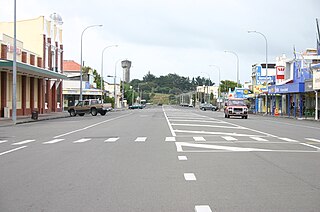
Foxton is a town in the Manawatū-Whanganui region of New Zealand - on the lower west coast of the North Island, in the Horowhenua district, 30 km (19 mi) southwest of Palmerston North and just north of Levin. The town is located close to the banks of the Manawatū River. It is situated on State Highway 1, roughly in the middle between Tongariro National Park and Wellington.

Manawatū-Whanganui is a region in the lower half of the North Island of New Zealand, whose main population centres are the cities of Palmerston North and Whanganui. It is administered by the Manawatū-Whanganui Regional Council, which operates under the name Horizons Regional Council.

Government House, Wellington, is the principal residence of the governor-general of New Zealand, the representative of the New Zealand head of state, King Charles III. Dame Cindy Kiro, who has been Governor-General since October 2021, currently resides there with her spouse, Richard Davies. The present building, the third Government House in Wellington, was completed in 1910, and is located in the suburb of Newtown.
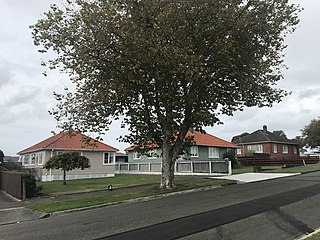
Roslyn is a suburb in the city of Palmerston North, Manawatū-Whanganui, New Zealand.
Hokowhitu is a riverside suburb of the New Zealand city of Palmerston North, with some of the highest property values in the city.

Awapuni is a suburb of Palmerston North, Manawatū-Whanganui, New Zealand. It is located south west of Palmerston North Central. The New Zealand Ministry for Culture and Heritage gives a translation of "blocked-up river" for Awapuni.
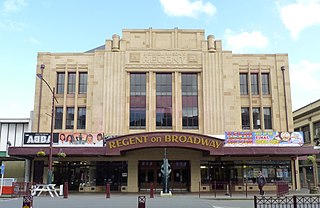
The Regent on Broadway is a large theatre in Palmerston North, New Zealand, named so because it is the Regent Theatre on Broadway Avenue.

Old Government House is the former residence of the governor of New Zealand in Auckland, New Zealand, listed by Heritage New Zealand as a Category I Historic Place.
Flock House was an agricultural and farm training school in Bulls, Rangitikei District, New Zealand from 1924 until 1987.

George Hamish Ormond Wilson was a New Zealand Member of Parliament representing the Labour Party, farmer, author and Chairman of the Historic Places Trust. He donated 30 acres of bush and his homestead to the Crown, which is now administered by the Manawatū District Council.
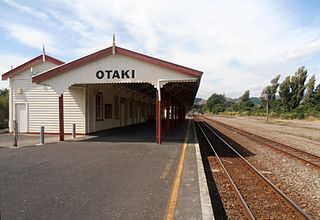
Ōtaki railway station is a station on the North Island Main Trunk railway line serving Ōtaki in the Kapiti Coast District of New Zealand. It is served by the Capital Connection long distance commuter train between Wellington and Palmerston North.

Mona Vale, with its homestead formerly known as Karewa, is a public park of 4 ha in the Christchurch suburb of Fendalton. The homestead and gate house are both listed as heritage buildings with Heritage New Zealand (NZHPT). The fernery and the rose garden, and pavilion with the setting of the park along the Avon River, add to the attractiveness of the property. It is one of the major tourist attractions of Christchurch.

Bushy Park Homestead is an Edwardian-era homestead located in the Bushy Park forest sanctuary, 8 km (5.0 mi) from Kai Iwi, in the Manawatū-Whanganui region of New Zealand. The homestead is registered as a Category I historic place by Heritage New Zealand.
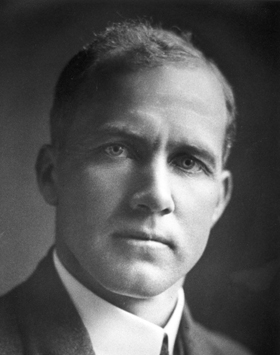
Arthur Montague "Joe" Ongley was a New Zealand lawyer, politician, and cricket and rugby union player and administrator. Born in Oamaru, he later lived in Wellington, Napier, and Hokitika, before settling in Feilding. He excelled in a number of sports and Ongley Park in Palmerston North, used for cricket and rugby, is named for him. His most notable sporting activity was as a cricketer, and he played four first-class matches. He served as an administrator on the New Zealand Cricket Council and was the organisation's president. He was a solicitor and then barrister in Feilding, and became Crown Solicitor in Palmerston North. He was a member of the Feilding Borough council and was the town's mayor from 1913 to 1919.
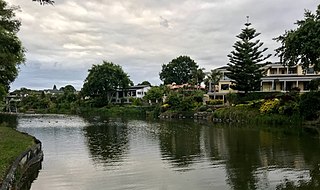
Hokowhitu Lagoon, also sometimes called Centennial Lagoon, is a natural oxbow lake in the city of Palmerston North, New Zealand. Hokowhitu was created from a meander of the Manawatu River. Many features surround the lagoon including a walkway, Caccia Birch House, and a former campus of a Massey University — the facilities of which are now used by the New Zealand Defence Force, Te Wānanga o Aotearoa and the Abbey Theatre Company. The lagoon also gives its name to the surrounding suburb, Hokowhitu.
William John Birch was an English settler in New Zealand. He leased with his brother a large area in inland Patea, central North Island, for a sheep run.

Massey University's Sir Geoffrey Peren Building, or Old Main Building as it was previously known, is located on the Manawatū campus of the university.



















